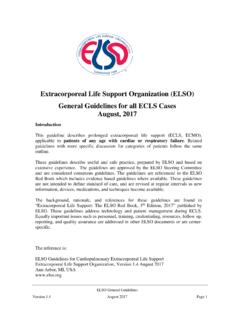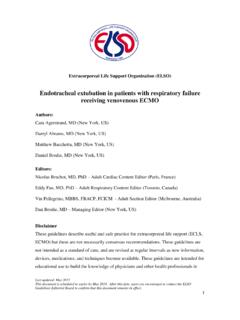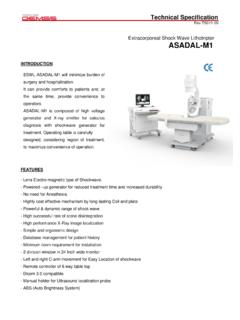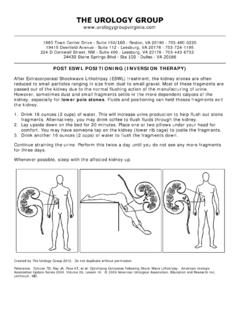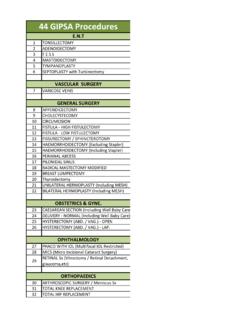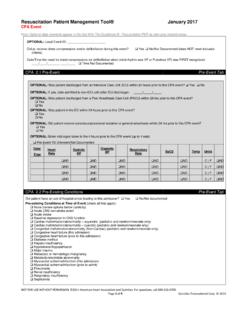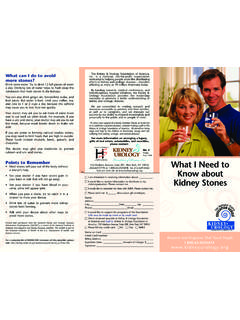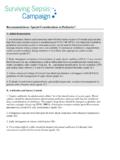Transcription of Extracorporeal Life Support Organization (ELSO) Guidelines ...
1 ELSO Adult Respiratory Failure Guidelines Version August 2017 Page 1 Extracorporeal life Support Organization (ELSO) Guidelines for Adult Respiratory Failure August, 2017 Introduction This guideline describes prolonged Extracorporeal life Support (ECLS, ECMO), applicable to adult patients with respiratory failure. These Guidelines are based on the general Guidelines for all ECMO patients. Anyone undertaking ECMO for adult respiratory failure should be thoroughly familiar with the general Guidelines before proceeding to adult respiratory ECMO. The general Guidelines are repeated where appropriate. These Guidelines describe useful and safe practice, prepared by ELSO and based on extensive experience.
2 The Guidelines are approved by the ELSO Steering Committee and are considered consensus Guidelines . The Guidelines are referenced to the ELSO Red Book which includes evidence based Guidelines where available. These Guidelines are not intended to define standard of care, and are revised at regular intervals as new information, devices, medications, and techniques become available. The background, rationale, and references for these Guidelines are found in Extracorporeal life Support : The ELSO Red Book, 5th Edition, 2017 published by ELSO. These Guidelines address technology and patient management during ECLS. Equally important issues such as personnel, training, credentialing, resources, follow up, reporting, and quality assurance are addressed in other ELSO documents or are center- specific.
3 The reference is: ELSO Guidelines for Cardiopulmonary Extracorporeal life Support Extracorporeal life Support Organization , Version August 2017 Ann Arbor, MI, USA ELSO Adult Respiratory Failure Guidelines Version August 2017 Page 2 Contents I. Patient Condition (Chapters 36, 37).. 5 A. Indications .. 5 B. Contraindications .. 5 C. Specific Patient Considerations (Chapter 36) .. 6 II. Extracorporeal Circuit (Chapters 4, 5) .. 6 A. Criteria for selecting circuit components .. 6 1. Blood flow for cardiac Support .. 7 2. Blood flow and gas exchange for respiratory failure (VA or VV) .. 7 B. Circuit components .. 7 C. Pump .. 7 1. Inlet (suction) pressure.
4 7 2. Outlet pressure .. 7 3. Power failure .. 8 4. Hemolysis .. 8 D. Membrane lung (often called the Oxygenator) (Chapters 4, 5) .. 8 E. Sweep 8 F. Priming the 9 G. Heat 9 H. Monitors .. 10 I. Alarms .. 10 J. Blood 11 K. Elective vs. emergency 11 III. Vascular Access (Chapters 4, 38) .. 11 A. Modes of vascular access for 11 1. Stable patients .. 11 2. Selective CO2 removal .. 11 3. Unstable 12 B. Cannulas .. 12 C. Cannulation .. 12 ELSO Adult Respiratory Failure Guidelines Version August 2017 Page 3 1. Methods .. 13 2. Cannulation technique .. 13 IV. Management during ECLS (Chapters 4, 5, 40,41).. 14 A. Circuit related Management .. 14 1. Blood flow.
5 14 2. 15 3. CO2 removal: (Chapter 63) .. 15 4. Anticoagulation (Chapters 6, 7, 8) .. 15 5. Circuit monitors, alarms, and safety (Chapters 4, 5) .. 17 6. Component and circuit changes .. 19 7. Traveling (Chapter 61) .. 19 B. Patient Related Management (Chapter 40,41) .. 20 1. Hemodynamics .. 20 2. Ventilator management .. 20 3. Sedation (Chapter 40,41) .. 22 4. Blood volume, flui d balance and hematocrit (Chapters 8, 41,) .. 23 5. Temperature .. 24 6. Renal and nutrition management (Chapters 4, 41, 62) .. 24 7. Infection and antibiotics .. 24 8. Positioning .. 24 9. Bleeding (Chapter 7) .. 24 10. Procedures (Chapter 6, 61) .. 26 V Weaning, Trials off, Discontinuing ECLS for Futility (Chapters 4, 42).
6 27 A. Weaning .. 27 1. Weaning adults from VV ECMO .. 27 B. Trial off .. 27 C. Decannulation .. 28 D. Stopping Support for futility .. 28 VI. Patient and Disease Specific Protocols (Chapter40,41,43,53,54,56,58,60) .. 28 A. Bronchoscopy .. 28 ELSO Adult Respiratory Failure Guidelines Version August 2017 Page 4 B. Management of air leaks .. 28 C. Selective CO2 removal .. 29 D. Pulmonary embolism .. 29 E. ARDS from secondary lung injury (following shock, trauma, sepsis, etc.) .. 30 F. Fluid overload .. 30 G. Post-ECLS recovery and management .. 30 H. Lung biopsy .. 31 I. Rare conditions .. 31 VII. Expected Results (Chapter 43).. 31 ELSO Adult Respiratory Failure Guidelines Version August 2017 Page 5 I.
7 Patient Condition (Chapters 36, 37) A. Indications 1. In hypoxic respiratory failure due to any cause (primary or secondary) ECLS should be considered when the risk of mortality is 50% or greater, and is indicated when the risk of mortality is 80% or greater. 50% mortality risk is associated with a PaO2/FiO2 < 150 on FiO2 > 90% and/or Murray score 2-31, AOI score 602, or APSS score 3 80% mortality risk is associated with a PaO2/FiO2 < 100 on FiO2> 90% and/or Murray score 3-4 (1), AOI >80 (2), APSS 8 (3) despite optimal care for 6 hours or less The best outcome in ECMO for adult respiratory failure occurs when ECMO is instituted early after onset (1-2 days) 1) MurrayJF, Matthay MA, Luce JM, Flick MR: An expanded definition of the adult respiratory distress syndrome [published erratum appears in Am Rev Respir Dis 1989 Apr; 139(4):1065].
8 American Review of Respiratory Disease 1988, 138:720-723. 2) Dechert RE, Park PK, Bartlett RH: Evaluation of the oxygenation index in adult respiratory failure. J Trauma Acute Care Surg 2014; 76:469 473 3) Villar J, Ambr s A, Soler JA, et al; Stratification and Outcome of Acute Respiratory Distress Syndrome (STANDARDS) Network: Age, Pao2/ Fio2, and Plateau Pressure Score: A Proposal for a Simple Outcome Score in Patients with the Acute Respiratory Distress Syndrome. Crit Care Med 2016; 44:1361 1369 2. CO2 retention on mechanical ventilation despite high Pplat (>30 cm H2O) 3. Severe air leak syndromes 4. Need for intubation in a patient on lung transplant list 5.
9 Immediate cardiac or respiratory collapse (PE, blocked airway, unresponsive to optimal care) B. Contraindications There are no absolute contraindications to ECLS, as each patient is considered individually with respect to risks and benefits. There are conditions, however, that are associated with a poor outcome despite ECLS, and can be considered relative contraindications. 1. Mechanical ventilation at high settings (FiO2 >.9, P-plat >30) for7 days or more. Many centers do not consider time on ventilation a contraindication. ELSO Adult Respiratory Failure Guidelines Version August 2017 Page 6 2. Major pharmacologic immunosuppression (absolute neutrophil count <400/mm3) 3.
10 CNS hemorrhage that is recent or expanding 4. Nonrecoverable comorbidity such as major CNS damage or terminal malignancy 5. Age: no specific age contraindication but consider increasing risk with increasing age C. Specific Patient Considerations (Chapter 36) 1. Primary causes of respiratory failure: Infection: Viral, bacterial, fungus, PCP. Primary lung disease: Cystic fibrosis, hemorrhagic auto immune diseases. Idiopathic fibrosis, sickle cell crisis, primary pulmonary hypertension Chest trauma, post pneumonectomy Posttransplant: acute, chronic (Bronchiolitis obliterans) Chronic respiratory failure bridging to transplant 2. Secondary causes of respiratory failure: ARDS due to shock, trauma, sepsis, ischemic tissue, DIC, reinfusion reaction, anaphylaxis Cardiac failure with pulmonary edema Fluid over load 3.
